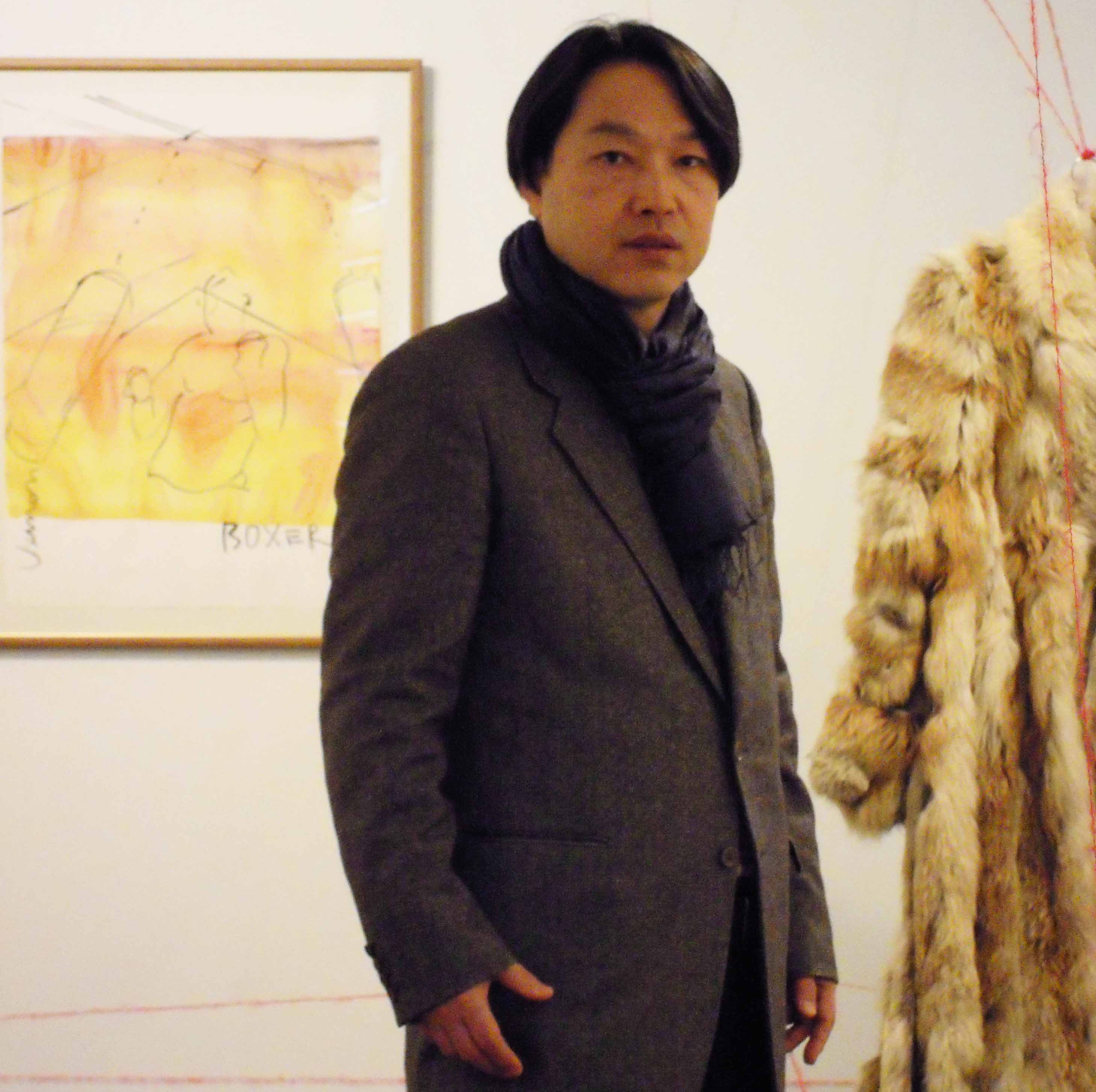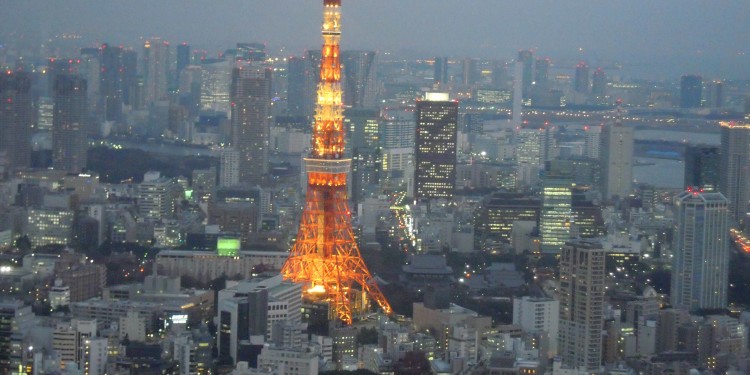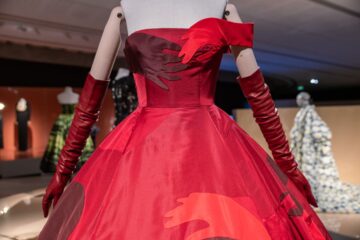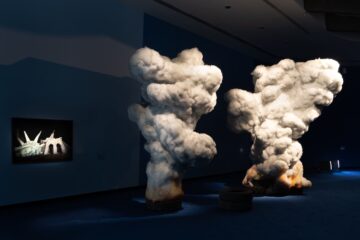2011 PROJECT / TRAVELERS ON THE BRIDGE – 2011プロジェクト・橋の上の旅人達


Text by Uemon Ikeda
2011 progetto/Viaggiatori sul ponte
racconto parallelo/sospetti di tragedia nel fiume
Quando la pioggia cadeva come fiume i pesci iniziano a volare nel cielo, si asciuga velocemente la terra battuta, trovavo tanti specchi d’acqua, stagno. Scoprivo le ali del pesce volante nel mondo, circondato dai colori delle persone sugli specchi d’acqua, specchiavano, dicono che alcuni pesci volando alto diventano draghi.
E’ giunta la fine di una guerra tirannica. Era solo un sospetto apparente, ma ora mi angoscia sapere ed immaginare i fatti, ovvero che una donna abbia perso la sua docile figlia, che un uomo abbia perso la sua donna e i figli, che dei bambini e delle bambine abbiano perso i loro genitori. Cosi i personaggi si risvegliano dall’apparenza, si accorgono che accanto a loro tutti gli amori hanno perso gli amati.
Questa volta la Scena è reale.
Calda estate sul fiume: una donna impazzita alla ricerca del suo dolce figlio rapito da un mercante di schiavi travolse la sua anima. Il fiume Sumida (Teatro di NO, “Sumida-gawa”) ostacola i suoi passi. La follia la spinse a raggiungere da sola questa estrema provincia e la stessa follia le permise di allontanarsi dalla Città senza impedimenti, perché nel medioevo, nell’epoca Heian nessuno osava avvicinarsi o toccare una donna impazzita, poiché la pazzia-follia della donna era considerata di origine supernaturale o divina.
Il fiume Sumida è largo.
Lei volle attraversarlo e chiese al traghettatore se era concesso salire sulla nave che divide lei dal figlio. Lui vedendo la donna di Kyoto diede per scontato che sapesse ballare e le propose: “Non posso farle attraversare il fiume da sola: aspetto anche gli altri. Nel frattempo perché non si esibisce in un ballo di follia?”
Lei aveva un elegante vestito da viaggio, con un cappello nero laccato ed un ramoscello di bambù in mano.
Sulla nave lei tornò in se ascoltando il traghettatore che raccontava agli altri viaggiatori della triste morte di un giovane ragazzo gravemente malato lasciato morire un anno fa sull’altra riva da un mercante di schiavi.
La salvezza per la donna alle volte contenuta nella sua tragedia stessa.
Prima di questa guerra, ho conosciuto un biologo-professore universitario, che lavorava nella fabbrica della Bambola – ballerina come sommozzatore per recuperare i pezzi persi nella sudicia e lorda cisterna in cui vengono conservate delle bambole prima di essere spedite con un cargo.
Mi ha raccontato della cartella-test che indicava la sicurezza degli operatori della Bambola.
“BALLERINA.
PER EVITARE DI FERIRE QUALCUNO CON UN MOVIMENTO BRUSCO DELLA BALLERINA, ASSICURATEVI, PRIMA DI PASSARE LA CARTA NELLA SUA TASCA CHE LA BALLERINA SIA IN POSIZIONE ZERO, CHE LA PRESSIONE DELL’ATMOSFERA DELLA BALLERINA SIA A ZERO E CHE NESSUN PIEDE Né GAMBA SIANO IN MOVIMENTO. IN OLTRE PRIMA DI PREMERE IL PULSANTE IN FUNZIONE O DURANTE L’INTRODUZIONE DEL BALLO, ASSICURATEVI CHE NON CI SIA NESSUNO ACCANTO ALLA BAMBOLA-BALLERINA.”
Il biologo, professore universitario, durante la guerra mi chiedeva come mi sentivo: come un viaggiatore destinato a compiere un lungo ritorno a casa.
I sospetti della tragedia sono caduti prima in un fiume, poi in una cisterna.
©14032011.Uemon
Position the cursor on the images to view captions, click on images to enlarge them.
Posizionare il cursore sulle immagini per leggere le didascalie; cliccare sulle immagini per ingrandirle.
2011プロジェクト・橋の上の旅人達
パラレルストーリー・川の中での、悲劇の疑惑
雨が川のように降るとき 魚たちは空を飛び始める。固められた土地は早く
乾き、私は、鏡のような水溜りをたくさん見出した。
私は、飛ぶ魚の羽を色彩と人影が映る水面の世界に見つけた、
ある魚は空を高く飛んで竜に成ると言われている
専制君主の戦争はやっと終焉した。はじめはただ表面的な疑いだった
然し、いま事実を知ること、イメージすることの苦痛に苛まれる。言い換え
れば、女は従順な娘を失い、男は女と子供を失い、子供たちは両親を亡くし
たこの様にして登場人物たちは、表面的な現象から目を覚ませ 身近に、全て
の愛は、愛した者たちを失ったことに気が付ついた。
今回、場面は現実である。
夏の暑い日、川で、「気が触れた女が奴隷商人に連れ去われた優しい息子を
探索して魂を病んだ。隅田川(能、隅田川)は彼女の歩みを妨げる 。
狂気はこの僻地まで一人で到達させ同じ狂気が都から障害なく行き着かせた。
なぜなら、中世の時代、平安時代に気の触れた女には誰も近づくことなく
触れたりもしなかった。
それは、狂気や狂気沙汰はもとを正せば超自然的な物、神聖な物であった。
墨田川は幅広い。
彼女は川を渡りたかった。船頭に子と彼女を隔てる船に乗ることを頼んだ
彼は京の都の女を見て、舞が舞えると思い一つの提案をした「客ひとりでは
この川を渡せない他の人らを待つことにするので、その間狂気の舞を舞って
みないか」尋ねた。
彼女は上品な旅衣装で装っていた、黒い漆で塗られた帽子と手に
竹の枝を持っていた。
船頭が一年前に奴隷商人が川岸に置き去りにした重い病の少年の死を他の旅
人らに語ったのを聞いて、船の上で彼女は正気に戻った、
救いは女にとって悲劇自体の中に含まれていることが良くある。
この戦争の前に私は生物学の大学の教授と知り合った、彼は
「踊り子人形」の工場に潜水夫として働いている
貨物船で送られる前に 踊り子人形が保存されている汚れた淀んだ貯水池に
部品を回収するために働いている。彼は人形を操作するオペレーターの
安全マニュアルのテキストについて語ってくれた。
「踊り子、
踊り子の出し抜けの動きで誰かを傷つけないために、安全を確かめる。
人形のポケットに紙を通す前に、踊り子の位置がポジション0であること
踊り子の気圧が0であること、どの足も腕も動いていないこと
また、稼動スイッチを押す前にまたは踊りの導入時には
踊り子人形の近くに誰もいない事を確かめること」
大学教授の生物学者は戦争の間に「どんな気分だ」と尋ねた。
私は「まるで長い帰郷の旅を運命づけられた旅人のようだ」と答えた
悲劇の疑惑はまず川にそして貯水池に向けられた。
©14032011.Uemon
..)(..
2011 project / travelers on the bridge
parallel story/ suspicious of tragedy in the river
When the rain fell like a river, the fish started flying in the sky as the clay dried quickly, I found many mirrors of water ponds, and pools. I discovered the wings of flying fish in the world, surrounded by the colors and people over the water mirrored, they say that some fish fly high and become dragons.
Here comes the end of a tyrannical war. It was just an apparent suspicion, but it anguishes me to imagine and know the facts, or rather that a woman has lost her docile daughter, that a man has lost his wife and children, that boys and girls have lost their parents. Thus the characters awake from the appearance, realizing that next to them all love have lost the beloved ones.
This time the scene is real.
Hot summer on the river: A woman went crazy looking for her sweet son, swept her soul away. The Sumida River (Theatre of NO, “Sumidagawa”) hinders its paces. The madness drove her to reach this extreme province and the same madness
allowed her to leave the city without hindrance, because in the Middle Ages of Heian era no one dared to approach or touch a woman that had gone mad, since the crazy-madness of the woman was considered to be of supernatural origine or divine.
The Sumida River is wide.
She wanted to cross it and asked the boatman if she was allowed to embark on the ship that separates her from the child. Seeing the woman from Kyoto, he took it for granted that she knew to dance and suggested: “I can not cross the river with you alone: I’ll away for the others. Meanwhile why don’t you perform a madness dance? ”
She was dressed in an elegant travel dress with a hat with a black lacquered and a sprig of bamboo in her hand.
On the ship she came to herself, listening to the ferryman telling other travelers the sad death of a young boy seriously ill left to die a year ago on the other side by a slave trader.
Salvation for the woman is contained in its own tragedy, at times.
Before this war, I met a biologist, university professor, who worked in the Doll-dancer Factory as a diver to retrieve the pieces lost in the messy and gross tank, where the dolls are stored before being shipped with a freighter.
He told me the folder-test indicating the safety of the Doll operators.
DANCERS
TO AVOID INJURING SOMEONE WITH THE SUDDEN MOVEMENT
OF THE DANCER, ASSURE, BEFORE PASSING THE PAPER
IN HER POCKET THAT THE DANCER IS IN POSITION ZERO THAT
THE PRESSURE OF THE ATMOSPHERE OF THE DANCER IS ZERO
THAT NIETHER FEET NOR LEG ARE IN MOVEMENT. FURTHER MORE
BEFORE PRESSING THE BUTTON IN FUNCTION OR DURING
THE INTRODUCTION OF THE DANCE, ASSURE THAT THERE IS
NO ONE NEXT TO THE DOLL-DANCER. ”
The biologist, university professor, asked me during the war how I felt: as a traveler fated to make a long journey home.
Suspicions of the tragedy have fallen the first into a river, then into a tank.
©14032 011.Uemon
..)(..
Uemon Ikeda (passport name Tatsuo Ikeda) was born in Kobe, Japan, back in April 5th 1952. His artistic past started at Accademia delle Belle Arti of Rome, his adoptive city, where he graduated in 1977. He has exhibited mostly in important galleries of Rome and Tokyo; since 1987, he is present in significant contemporary art international exhibitions. He works and lives in Rome. His expressional choices are certainly concentrated into conceptional aspects which are developed to differentiated language codes, which fluctuate from painting to architecture, sketch, installation and finally, writing. In 2001 Uemon Ikeda has completed an art book titled Acrobazia (Lithos editrice) together with Simonetta Lux.
Uemon Ikeda (nome anagrafico Tatsuo Ikeda) nasce a Kobe, in Giappone, il 5 Aprile del 1952. Il suo percorso artistico ha inizio presso l’Accademia delle Belle Arti di Roma, sua città di adozione, dove si diploma nel 1977. Ha esposto prevalentemente in importanti gallerie di Roma e di Tokyo; dal 1987 ad oggi è presente in significative rassegne internazionali di arte contemporanea. Vive e lavora a Roma. Le sue scelte espressive si concentrano su aspetti decisamente concettuali declinandosi in codici linguistici differenziati che oscillano dalla pittura all’architettura, dal disegno all’installazione fino a giungere alla scrittura. Nel 2001 Uemon Ikeda ha realizzato insieme a Simonetta Lux il libro d’arte Acrobazia (Lithos editrice).
Studio Marta Bianchi di comunicazione e immagine
Via Flaminia, 287 – scala D – 00196 Roma
Tel.: (+39) 06 3613726 – mob.: (+39) 392 7295258
www.inevoluzionet.com – mailto: inevoluzionet@gmail.com








No Comment